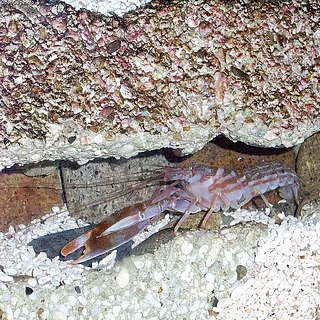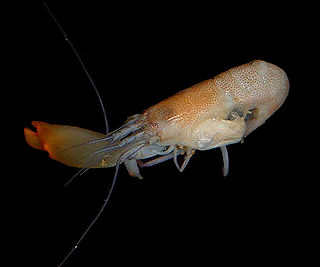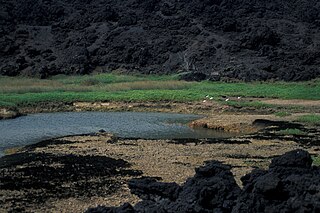
The tiger pistol shrimp belongs to the Alpheidae family, known commonly as snapping shrimp.

Punaluʻu Beach is a beach between Pāhala and Nāʻālehu on the Big Island of the U.S. state of Hawaii. The beach has black sand made of basalt and created by lava flowing into the ocean which explodes as it reaches the ocean and cools. This volcanic activity is in the Hawaiʻi Volcanoes National Park. Punaluʻu is frequented by endangered hawksbill and green turtles, which can often be seen basking on the black sand.

The EcoSphere and "Original Ecosphere" are trademark names for sealed blown-glass miniature aquaria formerly produced by Ecosphere Associates, Inc., of Tucson, Arizona, United States. Spherical or ovoid, the aquaria range from roughly pool-ball-size to basket-ball-size. They are sold worldwide as scientific novelties and decorative objects.

Vernal pools, also called vernal ponds or ephemeral pools, are seasonal pools of water that provide habitat for distinctive plants and animals. They are considered to be a distinctive type of wetland usually devoid of fish, and thus allow the safe development of natal amphibian and insect species unable to withstand competition or predation by fish. Certain tropical fish lineages have however adapted to this habitat specifically.

Alpheidae is a family within the infraorder caridea characterized by having asymmetrical claws, the larger of which is typically capable of producing a loud snapping sound.

Halocaridina rubra, the Hawaiian red shrimp or volcano shrimp is a small red shrimp of the family Atyidae, with the common Hawaiian name ʻōpaeʻula.

Synalpheus is a genus of snapping shrimp of the family Alpheidae, presently containing more than 160 species; new ones are described on a regular basis, and the exact number even of described species is disputed.

The Hawaiian coot, also known as the ʻ'alae ke'oke'o in Hawaiian, is a bird in the rail family, Rallidae, that is endemic to Hawaiʻi. In Hawaiian, ʻalae is a noun and means mud hen. Kea or its synonym keo is an adjective for white. It is similar to the American coot at 33–40.6 cm (13–16 in) in length and weighing around 700 g. It has black plumage and a prominent white frontal shield. Its natural habitats are freshwater lakes, freshwater marshes, coastal saline lagoons, and water storage areas. The bird was federally listed in October 1970 as an endangered species and is considered both endemic and endangered by the state of Hawaii. It is threatened by habitat loss and introduced predators such as the small Asian mongoose. The Makalawena Marsh on the Big Island of Hawaiʻi has been listed as a National Natural Landmark to preserve one of its last nesting areas.
The midvalley fairy shrimp, Branchinecta mesovallensis, is a small freshwater crustacean in the Branchinectidae family endemic to shallow ephemeral pools near the middle of California's Central Valley. These vernal pool ecosystems are home to other unique organisms adapted to the ephemeral nature of the water cycle in the pools in California's mediterranean climate.

Branchinecta sandiegonensis is a rare species of crustacean in the family Branchinectidae and the order Anostraca, the fairy shrimp. Commonly known as the San Diego fairy shrimp, it is named after the vernal pools found in San Diego County, California, where this species was originally discovered. It is also a federally listed endangered species of the United States.

Streptocephalus woottoni, with the common name Riverside fairy shrimp, is a rare species of crustacean in the family Streptocephalidae. It is native to Southern California in the United States, and northern Baja California in northwest Mexico.

Waiʻanapanapa State Park is a 122-acre (0.49 km2) state park in Hana, on the island of Maui, in Hawaii. It is located at the end of Waiʻanapanapa Road off Hana Highway at mile marker 32, 53 miles (85 km) east of Kahului, Maui. Waiʻanapanapa means "glistening fresh water" in the Hawaiian language, referring to nearby fresh water streams and sparkling pools. The camp offers camping facilities, including a small lawn where campers may pitch a tent, and a public bathroom nearby.

Alpheus randalli is a species of snapping shrimp in the family Alpheidae. It lives in the Marquesas Islands and parts of the Indian Ocean, including the Seychelles, in association with a goby of the genus Amblyeleotris. The shrimp is transparent or white with prominent red markings.
The Pearl Harbor National Wildlife Refuge is a National Wildlife Refuge on the island of Oʻahu, Hawaii. It was created in 1972 to mitigate the wildlife resource disturbances caused by construction of the Honolulu International Airport Reef Runway. The Refuge includes three units, the Honouliuli, Waiwa and Kalaeloa. The Honouliuli and Waiawa Units are managed under a cooperative agreement with the United States Navy. The Kalaeloa Unit was established during Base Realignment and Closure proceedings in 2001. Through these cooperative efforts with the Federal Aviation Administration, the State of Hawaii, and the U.S. Navy, the U.S. Fish and Wildlife Service made Pearl Harbor NWR a reality.

Established in 1973, ʻĀhihi-Kīnaʻu Natural Area Reserve includes a coastal lava field and surrounding waters on the southwest coast of the island of Maui, Hawaii. It consists of 1,238 acres (501 ha) on land and 807 acres (327 ha) of ocean along 3 miles (4.8 km) of Maui's southwestern coastline. The reserve includes several popular snorkeling/diving sites and many cultural and geologic sites as well as habitat for numerous rare and endangered species. The purpose and intent of the Reserve is to preserve and protect three unique components: the geologic setting of the most recent lava flow on Maui; unique assemblages of nearshore coral reef ecosystems; and the anchialine ponds found there.
Calliasmata pholidota is a species of shrimp in the family Barbouriidae. It is thought C. pholidota is an opportunistic feeder, taking live prey or scavenging for food.

Athanas areteformis is a species of small alpheid shrimp from the Indo-West Pacific.
An anchialine system is a landlocked body of water with a subterranean connection to the ocean. Depending on its formation, these systems can exist in one of two primary forms: pools or caves. The primary differentiating characteristics between pools and caves is the availability of light; cave systems are generally aphotic while pools are euphotic. The difference in light availability has a large influence on the biology of a given system. Anchialine systems are a feature of coastal aquifers which are density stratified, with water near the surface being fresh or brackish, and saline water intruding from the coast at depth. Depending on the site, it is sometimes possible to access the deeper saline water directly in the anchialine pool, or sometimes it may be accessible by cave diving.
Metabetaeus minutus is a species of alpheid shrimp native to the Indo-West Pacific.















